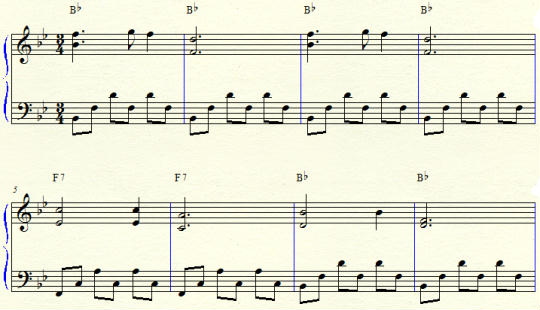Free Lessons
Reharmonization on "Silent Night"
I was looking at my stats today and noticed that one of my most read blog posts lately was this one about harmony in “Have Yourself a Merry Little Christmas.” So I thought I would do a similar post today.
Yes, I am going to do another Christmas song in this post. A few weeks ago, a great church asked me to come do a Christmas concert, which I usually don’t do. However, I just couldn’t turn this one down, and now I need to learn some Christmas music. So I have already started dabbling in it.
The song for the day is “Silent Night.” Here is the harmony for the first line as you would find it in a hymnal.

Now, here is a reharmonization:

Now, let’s walk through what I have done. Before we do, let me remind you of a few guidelines:
1) I am not looking at this as substituting chords. I am actually looking at how to change entire progressions. If you want to get past the most basic chord substitutions (such as iii for I), you have to start thinking this way.
2) Practically ANY chord you choose will work in a given situation if it logically relates to the chords around it and it works with the melody note (which it will more often than you think).
Let’s take the first four measures first. Originally, all four were just Bb. I have replaced those chords with a progression that starts and ends on Bb. This is a very common way to reharmonize.
What I am actually thinking here is that I know I need to end those four measures on a Bb but I can choose any number of paths to get there. My first chord change is Ebmin which is the minor iv chord. I chose this chord because of where it typically wants to resolve–either the I or iii chord. Here I resolved it to the iii chord (Dmin7) in bar 3.
I then just stepped down to Cmin and did a ii7-V7-I progression to finish out those 4 bars. Remember that chords like to step in either direction and movement around the circle always sounds good.
So, after moving to the minor iv, I stepped down twice and then moved around the circle of fifths. These are all natural and planned movements.
In the second four bars, I used a few tritone substitutions. The first one is the B7 in bar 5. B7 is a tritone away from F7. Remember that you can always substitute the dominant a tritone away from any dominant chord.
After returning to F7 at the start of bar 6, I step up to F#dim7. I will discuss what is happening with the diminished chord later. Technically, that diminished chord is functioning as a D7, but for the moment, just note that we are stepping. We then step up one more half step to Gmin7.
Of course, Gmin7 is the vi chord and nicely resolves down a fifth to C7. Rather than doing that, I step down to the tritone sub of C7 (F#7). I then step down another half step to Fsus.
Now, I know that this may seem confusing at first. I want you to note that it is following simple rules of functional harmony. You can come up with your own progressions just using the simple rules we have discussed here such as moving in steps or around the circle of fifths.
I should point out also that this harmony sounds good because the melody notes do not always fit into the triads of the chord. For example, note that the melody note is the 11th on the Cmin7 in bar 3 and the b9th on the B7 in bar 5. Don’t be scared to get the melody note out of the triad whenever you can. You can for example, put a dominant chord with a melody note that is 1, b9, 9, #9, 3, #11, 5, b13, 13, and 7.
By the way, I do not plug my course enough. In it, this theory is laid out in a logical way that you can learn in simple steps. You can read more here.
